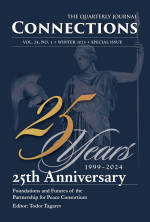Reflecting on the 25th anniversary of the Partnership for Peace Consortium, this introductory article examines its pivotal role in fostering peace, security, and cooperation across Europe and beyond. Established in a tumultuous post-Soviet landscape, the Consortium has navigated complex geopolitical shifts while advocating for collaborative approaches to conflict resolution, progressive visions for Europe and NATO, and the achievement of sustainable peace. By reviewing the articles in this issue of Connections and the Consortium’s contributions to regional stability, democratic reform, and educational development, this article showcases the transformative impact of its various working and study groups. Topics range from defense cooperation in Southeast Europe to the evolution of military education in response to contemporary security challenges, such as hybrid warfare and disinformation. The article emphasizes the ongoing need for innovative governance and adaptive methodologies to address emerging threats, as well as the importance of historical understanding in shaping modern security strategies. Ultimately, this reflection underscores the Consortium’s enduring commitment to enhancing global security cooperation and its vital role in promoting democratic values amidst evolving security challenges.
Editorial
When It Is Dark Enough, You Can See the Stars: A 25th Anniversary Reflection
Article statistics
Bibliography
Bilban, Christoph, Frederic Labarre, and George Niculescu, eds., Does the EU Need a Strategy for the South Caucasus? (Vienna, Austria: Federal Ministry of Defence, 2024), https://www.bmlv.gv.at/pdf_pool/publikationen/rssc_sgi_24_14_webversion.pdf.
Masters, Roger D., “Gradualism and Discontinuous Change in Evolutionary Theory and Political Philosophy,” Journal of Social and Biological Structures 12, no. 2-3 (1989): 281-301, https://doi.org/10.1016/0140-1750(89)90051-1.
Rickli, Jean-Marc, and Gëzim Vllasi, “The Weaponization of Emerging Technologies and Their Impact on Global Risk: A Perspective from the PfPC Emerging Security Challenges Working Group,” Connections: The Quarterly Journal 24, no. 1 (2025): 93-112, https://doi.org/10.11610/Connections.24.1.07.
Schatz, Sae, Olaf Garlich, and Scott Buchanan, “A Theory of Change: 25 Years of the Partnership for Peace Consortium,” Connections: The Quarterly Journal 24, no. 1 (2025): 149-168, https://doi.org/10.11610/Connections.24.1.10.
Secord, Arthur H., “Condensed History Lesson,” Readers’ Digest 38, no. 226 (February 1941), 20.
Tagarev, Todor, and Philipp Fluri, “From Civil-Military Relations to Resilience: The Fifth Wave of Strengthening Democracy through Research and Education,” Connections: The Quarterly Journal 24, no. 1 (2025): 73-90, https://doi.org/10.11610/Connections.24.1.06.

